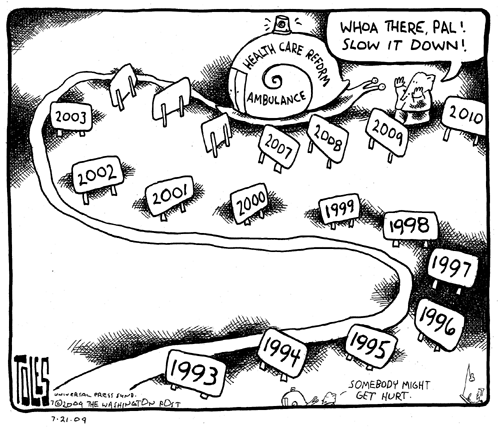Cartoon

(Toles 1)
The cartoonist portrays the factors influencing the pace of the healthcare reform process in the United States. He suggests that the process has been very slow and has suffered several setbacks.
In spite of the fact that the whole procedure of reforming the healthcare sector has covered a period more than a decade, there are massive political efforts adding some slack the process. The cartoonist demonstrates the parties involved in the healthcare reform bound to suffer from the pace of the reform process.
The cartoonist mainly uses metaphors to pass his message. He likens the pace of the reform process to that of a snail meaning that the process has been very slow. In fact, he uses the picture of snail as an ambulance carrying the reform process in its back. In this case, reform process is seen to be in a critical point as symbolized by the ambulatory function of the snail carrying the reform process (Toles 1).
The winding path used by the proverbial snail ambulance indicates that the process itself has not been progressive with regard to the achievements made to complete the process. In addition, the cartoonist adds a time frame to the winding path which gives an indicator of the years that the process suffered setbacks. This means that the process took a period of more than a decade.
The cartoonist also employs personification to relay his message. An elephant asking the snail to reduce the pace is drawn at the end of the path to suggest that some stakeholders have tried to thwart the reforms. The human ability to talk is attributed to the two animals, and for that reason, presents the use of personification as a literary stylistic device.
The stakeholders in this case have massive influence on the whole process represented by the elephant image interacting with the small snail. The allegorical snail portrays the burden carried in the reform process since the snail is known to carry its shell on its back (Sheppard 21).
At the foot of the cartoon, the elephant intimidates the snail ambulance that some people might get hurt in the reform process. This shows that some political bigwigs argue that the position of the reform process may be detrimental to some extent.
Figuratively the snail is pictured as bigger than the elephant in the cartoon. This is symbolic of the weight that the reform processes and effort carries over the individual needs of the reform stakeholders
The cartoonist exaggerates the pace, which the stakeholders would want to be used in the reform process. The snail pace is proverbially known to be the slowest pace, however, the parties would want the slowest speed be slackened the more. Their influence makes the reform process sluggish, which is portrayed in the year 2010 by the elephant standing on the year’s mark (Sheppard32).
The audience of this cartoon will need to correlate the process of perform reforms within the healthcare sector and its impact on the society. One must reckon the fact that the process was established some times in the past and has arrived its critical stages.
The reader must also notice that there exist stakeholders with vested interests in the whole reform process who have been a hindrance to its progress.
A reader can offer a rebuttal to the cartoonist claim that the stakeholders influence the process in a detrimental manner. This is attributed to the reform process that is meant to be beneficial to all parties. This means that no matter how long it takes to carry out the reforms, all efforts to achieve an all-beneficial policy is valid, and for that reason, it should not be viewed negatively.
Works Cited
Sheppard, Alice. Cartooning for suffrage. Albuquerque: University of New Mexico Press, 2008. Print.
Toles, Tom. “Political cartoon on health care reform in the United States. – Right to Health Care – ProCon.org.” Right to Health Care ProCon.org. N.p.,2009.